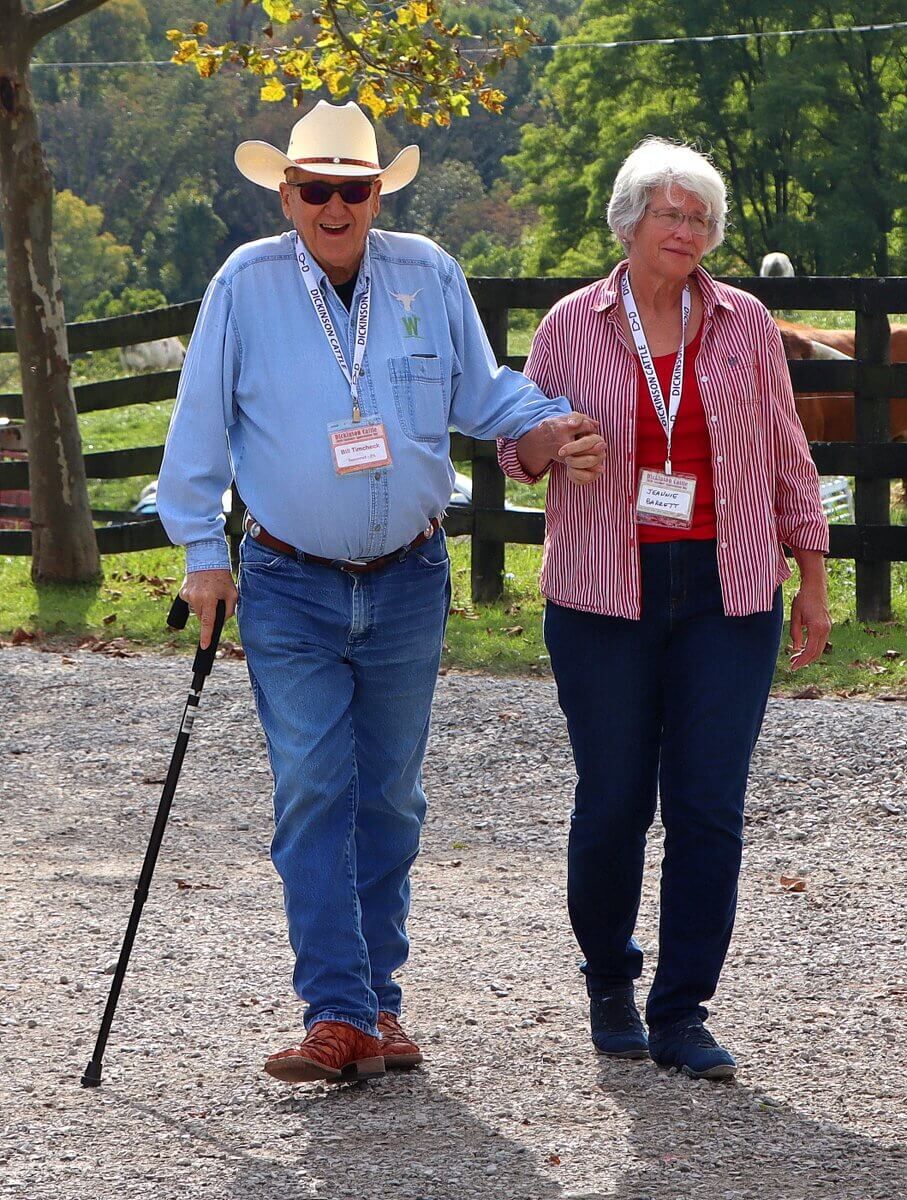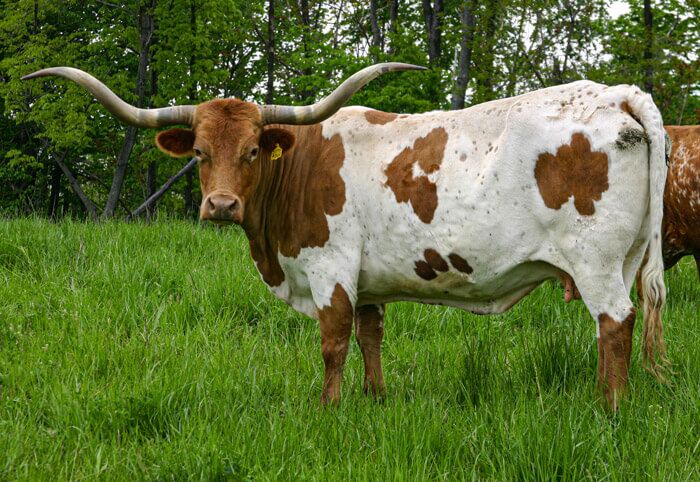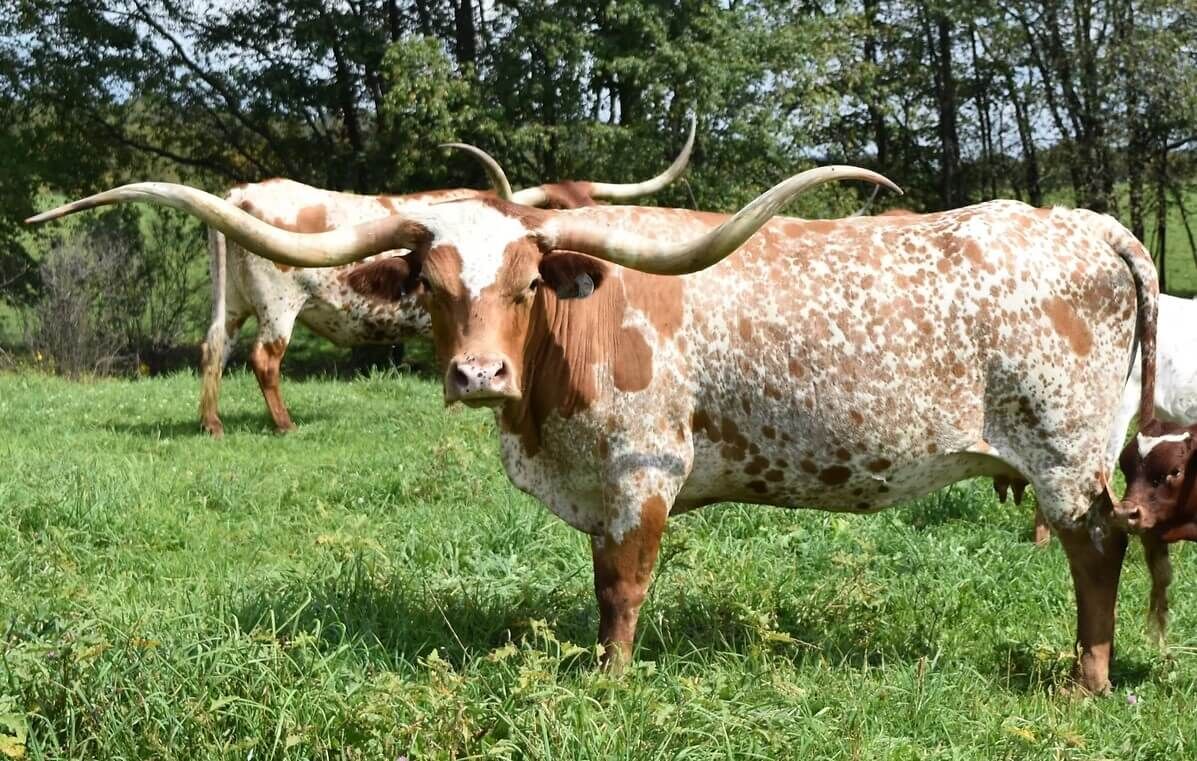William Timcheck of Somerset, PA, is not a name that many in Texas Longhorn circles will quickly recall. However, "WT" signifies none other than William Timcheck in the official name of WT Kid Rock —the fastest-horn-growing bull in history. Most haven’t seen the WT, but here is the exciting story of a man with a dream about Texas Longhorns. In southwestern Pennsylvania, that dream took a lifetime to achieve—and it did, magnificently. Hang on for some Timcheck history, bouncing all over the world.
TLH - Newsletter (englisch)
Used courtesy of Dickinson Cattle Co. USA

William Timcheck, Before & After
Erstellt am: von Longhorn
DCC Ranch e-News #315 - 5-02-23
by Darol Dickinson

There were certain Tri-W cows that I really wanted: the daughters of Doherty 698, full sisters to Overwhelmer, Tri-W Marika, Tri-W Paprika, and what I thought was the plum of the herd, Tri-W Legends Jitterbug. Jitterbug was the biggest Tri-W cow with the most horn and a hip as big as a wash tub. I had tried for years to buy her and cherry-pick some of the top Tri-W cows. So had many others, including Joe Valentine. We were all unsuccessful. Here’s why.

Wayne Rumley was never easy. He had been in the oil-field cooling industry all his life and was used to negotiating pennies with the brutality of Attila the Hun. But the Tri-W herd had grown too big and he needed a solution. He did not have time from his business to market the herd privately and liquidate on his own. He did not want to have a Longhorn auction of 763 cattle, nor did he want to take them all to a local generic auction. He especially did not want to deal one at a time with a hundred buyers driving around the pastures dickering for hours.
Now at last he was willing to sell the herd—but absolutely no cherry-picking.
My son Joel and I drove to the Tri-W south of Tulsa, where Rumley gave us a two-inch-thick stack of registration certificate copies. The ranch was just under 4,000 acres, well fenced, and managed in eight pastures. On paper, we divided the herd of 763 into categories of bulls, pairs, dry cows, and old barren cows. We did not want any of the bulls, and all the heifers had already been taken to a local auction and tossed to the wind for several years.
This Tri-W plan didn’t totally win the approval of my wife. Linda said, "What in the world are you doing? We have cattle in Ohio to sell. You are crazy." Wives always have a perception that whacks you up-side the head and absolutely must be considered.
After some thought, I told her it was an exercise in my marketing skills. I needed to do something really hard, and this would be a tough test. Most buyers wanted only the top 30 cows. Disposing of the other 733 head would be the difficult part. Fortunately, the line of my competitors was short, because few others wanted to make an offer for all the cattle in one package.
Rumley understood that we would not write just one check for the entire herd, so he allowed us some time. That was fine. Joel and I made an offer for all 763 Texas Longhorns—so much for each pair, each dry, and each barren. We were to liquidate the whole herd within a year and pay for each cow when they left the ranch. Each would have a veterinarian’s health certificate. Rumley would pay for the certificates and transfers to the new buyers. The Tri-W ranch hands would handle the cattle. We were ready to go to work.
I drove to the old oil town of Glenpool, OK, and checked in at the Holiday Inn on a one-month rate. I had a camera, a laptop, some camera cards, and a flip-phone. I wanted to study the herd for three days to memorize pedigrees, but that plan wasn’t to be. Tri-W had dominated the show circuit and people had been trying to "get to" this herd for years. When I arrived at Tri-W, the word about our deal was already out and the driveway was full of trailers. For years, Rumley wouldn't show or price the cattle to anyone else. He wouldn’t mess with onesies and twosies. He left it all up to Joel and me.
At the end of the week, we had sold and shipped 100 cattle. I opened a local bank account to deal with deposits. Good cattle are always easy to sell, but the others are time-consuming.

I wanted the skulls from the big, twisty-horned, barren cows. However, getting skulls from the slaughter house was a problem. Plant owners had apparently taken a course in "No, we don't do that." One day with the yellow pages in my motel room, I called every processing plant for miles around Glenpool. After making more than twenty futile calls, I still owned about 40 old barren cows.
The next day, I called a larger circle all over northeastern Oklahoma. If a buyer would take truck loads, I did not mind hauling some cattle a few hundred miles, even up into Missouri. Finally, after nearly 50 calls, I found Nowatta Pack, owned by the McFerron family. They needed lean trim to blend with beef from their overly fattened, grain-fed steers. Mr. McFerron would take six per week—and I would get the skulls back. He was so pleased with the deal that about halfway through the barren-cow herd, he decided to come to Tri-W with his own trailer and pick up the cattle every week.
Although several hundred cows found homes, one was a problem that I had not been told about up front. She would jump the moon or duck into the brush or do anything to escape. In the pasture, she seemed normal around the other cows, but she was so wild that the ranch hands refused to try to catch her. I was stymied about how to get rid of her.
While in Glenpool, I had found a good Baptist church and was attending regularly. Some of the members were fascinated by my crazy business dealings with the Tri-W, and the pastor said that every year or so he processed a critter for freezer beef. He knew a mobile processor who would shoot a cow in the pasture and process it.
I owned an excellent candidate for the pastor's freezer. I told the Tri-W hands that I had sold the problem cow but was concerned that the right animal be shot. I needed them to meet the mobile unit so they should point her out. They all agreed to help spot her, only with the agreement that they got to watch her meet her end. In a few days, the preacher’s freezer was full. The hands at Tri-W had worried for weeks as to how this would pan-out, now they were very happy.
After these sales and "arrangements," just over 200 of the original 763 cattle remained at Tri-W. These were the best of the herd that I had held back and another group the "horn-lovers" had picked over. They were thick pairs with pretty conformation but less horn. Several large ranches wanted to add Texas Longhorns to their herds. Tom Hogan of Garryowen, MT, wanted Texas Longhorn females so he bought 73 head, most with calves. We loaded them on two semis for the trip north on May 20, 2005.
Back to Tri-W Legends Jitterbug, the big, beautiful plum of the Tri-W herd. I was eager to move her to our Dickinson Cattle Co (DCC) in Ohio. But when I arrived at Tri-W one morning, I learned that she had calved a spotted heifer. Unfortunately, her udder was caked-up and not providing for the calf. The hands didn't know when the heifer was born, and she was near death. I quickly found this little dehydrated baby and as fast as possible poured some milk formula down her. With a few feedings, she filled up her energy tank and bounced back to normal.
Finally, after 30 days the Tri-W job was nearly complete. What was left of the original herd was a motley assortment of cows, one orphaned heifer, and dozens of raw skulls. From then on, with photos and the internet I could sell the rest from Ohio. So I paid Tri-W for the 55 pair I wanted to keep and loaded them on a semi truck to DCC in Ohio.
Before leaving Tri-W, I went to the local Walmart, bought their largest dog crate, loaded my Suburban with the orphan heifer, powdered milk, and a bottle, and prepared to drive to Ohio. I planned to stop every so often at a Burger King, get a double Whopper with jalapeños for myself and hot water to mix for my bottle-baby orphan. During the trip, when I opened the back hatch of the Suburban, this beautiful heifer would get excited and drink like crazy. She didn't have a mother, but we quickly became fast friends.
We were home at last to DCC in Ohio, where Tri-W Legends Jitterbug settled into her new quarters. She was bred to Superb, a son of Super Bowl, and produced Jitter Soup. Jitter Soup was bred to Over Kill and produced Killer Soup on June 7, 2010. On August 25, 2011, William "Bill" Timcheck bought Killer Soup for $900.

Now back to William Timcheck and the history of the "WT" in WT Kid Rock ’s name.
Each year Bill attended the Dickinson Cattle Co’s annual Customer Appreciation Day (CAD) held on the last Saturday of September. He loved the breed and would usually buy one to four heifers each time he came to the ranch. As his calves were born, frequently from AI, he brought them to be branded during CAD, typically three to eight calves every year. His friend Curtis Hamer often drove for him.
In the Fall of 2018, Joel Dickinson noticed an outstanding bull among Bill’s calves and commented that it might be very special. The little bull was an AI son of the Stahl bull MC Mr Big Stuff and out of Killer Soup. Bill was excited that Joel thought he had raised a really good calf and named him WT Mr Big Kill.
As WT Mr. Big Kill came of breeding age, Bill decided that he had too many bulls. He did not want to sell him, yet needed to reduce his bull population. Robert Rowan of Vanderbilt, PA, bought WT Mr. Big Kill with the agreement that Bill could get him back in the future. When that time came, however, Rowan could not be found, and the bull was lost. But a year later Bill got a phone call from Denton Martin, who badly needed to eliminate his cattle herd—including a Longhorn bull from Robert Rowan. Bill raced over to see Martin’s cattle. After considerable dickering, he purchased the entire herd and WT Mr. Big Kill came home with a group of mixed-breed cattle. This was a day Bill said he would never forget.
Now here’s some background on Bill. He was very patriotic as a result of his military service. He was drafted into the U.S. Army infantry for Vietnam and during the Gulf War re-enlisted in the Airborne Army Reserves as staff-rank Sergeant E1. He turned 21 in Vietnam, where his rank was Specialist E4, and his battleground was Con Thien, Landing Zone Nancy for artillery protection along the Dong Ha River. Like many who fought in Vietnam, Bill was very quiet about that brutal conflict. When he completed his service he returned to Pennsylvania and worked most of his life at Duquesne Light Plant, quickly becoming lead mechanic.
Unfortunately, like so many Vietnam servicemen, he suffered from health issues caused by the Agent Orange defoliant. Chronic problems involving heart, liver, and other reactions forced him to live in and out of hospitals much of the rest of his adult life.
Despite his health issues, Bill wanted to keep life exciting. He longed to be a cowboy and was determined to be a professional bull rider in the Eastern Circuit. He loved the West and sported several expensive cowboy boots and hats. He took some guff about his Western attire from family and friends in Pennsylvania, but it was part of him everywhere he went.
While bull-riding, serving in the military, working at Duquesne, and raising a family, Bill fell in love with Texas Longhorns and built up a herd. He bought semen from the most popular bulls like Cowboy Tuff Chex (@ $300 a straw), Mary Stahls’ best bulls, and Dickinson Cattle Co’s sires. In everything he targeted, he went all the way for quality.
With his friend Curtis Hamer, Bill brought some calves to brand at DCC’s 2021 fall CAD. He was especially excited about recovering WT Mr. Big Kill. His neighbors Mary and Brian Stahl had helped measure the young bull—and the data was off the charts. He had never dreamed of having the problem of how to promote a high-value bull. I tried to buy WT Mr. Big Kill or at least semen. Bill said “No,” but that if he decided to sell, he would give me first chance. He also told me some sad things about his declining health, indicating that his time was short.

On May 1, 2022, Bill called and said he owed me an apology, that he had a prior obligation on the bull and could not keep his word. He wanted to give me semen from the first collection as a gesture of good faith. Three weeks later, on May 20, 2022, he passed away. Per one of his final wishes, DCC received a generous supply of WT Mr. Big Kill semen. During the next year (2023) more than twenty DCC calves were born by artificial insemination, with more on the way from the famous "WT" bull.
WT Mr. Big Kill was then purchased by C2W Partners, who took him to Texas and changed his name to WT Kid Rock. The future of Bill's bull is yet to be seen as only a few calves by him have been born so far—but now, for certain, everyone knows what "WT" is.
William Timcheck's obituary states, "In his later years, Bill continued to engage in many different activities. Most notably, he raised Texas Longhorn cattle. The horn spread of his largest bull, “WT Mr. Big Kill, ” currently ranks as the fastest horn growth of any living Texas Longhorn bull."
* * *
Thanks to Joe Timcheck, Curtis Hamer, David A. Richardson, Mary Stahl, Wayne Rumley, Mary Timcheck, and Bill Timcheck himself.
Dickinson Cattle Co., Inc.; 35000 Muskrat Rd.; Barnesville, OH 43713; 740 758-5050
